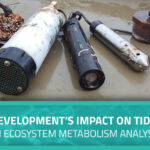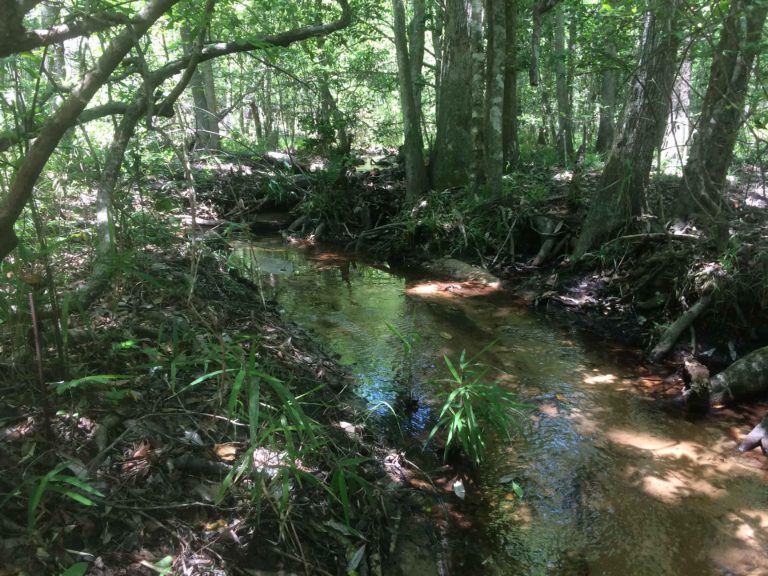
Coastal Development’s Impact on Tidal Creeks: An Ecosystem Metabolism Analysis
February 20, 2023
Zebra Mussels: Aquatic Invaders
April 17, 2023Measuring Ecosystem Metabolism After Stream Restoration
Project Details
- PRODUCT(S): miniDOT® Logger
- APPLICATION: Surface Water
- PARAMETER: Dissolved Oxygen
- LOCATION: Fort Benning Military Installation, GA
- ORGANIZATION: Auburn University
- RECOGNITION: Samuel Bickley, Ph.D

Case Study Description
Dams constructed of coarse woody debris (CWD) have long been used as a cost-effective approach for stream restoration efforts. Despite its relative prevalence, little is known about CWD’s long-term ecological impacts and efficiency in reducing erosion. In his doctoral dissertation Samuel Bickley, Ph.D., conducted several studies using data gathered from PME’s miniDOT® logger; the first of which was designed to shed light on the long-term effects that CWD additions had on the streams they were meant to benefit.
The comparative study featured here assesses freshwater stream ecosystem metabolism fourteen years after initial restoration efforts and is the first of two case studies highlighting the recent Auburn University Graduate’s research.
Woody Debris and Stream Ecology
Long before Bickley began his post-graduate education, eight streams located in the Fort Benning Military Installation were being monitored for a different study. Four of the freshwater streams were scheduled to undergo CWD restoration in 2003 and the remaining four were to be left unaltered as a control. The researchers conducting this initial study monitored the streams in the years leading up to the restoration and for an additional three years after the restoration. Fourteen years after the first researchers had completed their analyses, Bickley chose seven of these same streams as sites for his own research to investigate the seldom explored long-term effects of CWD restoration.
To assess changes in the steams, Bickley compared his recent measurements of several variables against the measurements recorded by the previous researchers. These variables included nutrient uptake, water quality factors and overall ecosystem metabolism. Ecosystem metabolism is the difference between an ecosystem’s respiration and gross primary production. Ecosystem respiration (ER) refers to the sum of carbon dioxide produced by organisms within an ecosystem whereas gross primary production (GPP) refers to the synthesis of carbon dioxide into organic compounds. Early monitoring of sites post-restoration showed no change in water quality variables but did reflect an initial spike in nutrient uptake and stream metabolism, which lessened in the years immediately following restoration.
Methods and Observations
Shortly after arriving at the site, Bickley was faced with a complication that challenged his study’s planned comparison. Accurate assessment of ecosystem metabolism relies on GPP measurements, but conditions at the time of Bickley’s study could not provide sufficient GPP for modern models to estimate stream metabolism accurately. Still, Bickley was able to estimate whole-stream metabolism by instead measuring characteristics present in the streams’ diurnal dissolved oxygen (DO) profile with PME’s miniDOT® logger. Previous research had shown that DO levels could correlate with GPP and ER, offering an alternative method of calculating ecosystem metabolism.
For this study, several miniDOT®s had been deployed in the small, sandy streams at average depths of just eight inches below the water surface. These miniDOT®s provided data on the streams’ dissolved oxygen (DO) levels for five seasons beginning in the summer of 2017 through the autumn of 2018. Due to the sandy conditions of the streams, heavy rainfall could cause shifts in the streambeds, leading the miniDOT®s to be occasionally buried or otherwise fouled by the disturbed sand. Despite these disturbances, the miniDOT®s provided the necessary data that allowed Bickley to draw conclusions regarding the long-term impact and efficacy of CWD damming.
By comparing prior data to his own recent data across the altered and unaltered streams, Bickley’s study found that CWD dams ultimately provided minimal long-term benefits in circumventing or mitigating watershed disturbance. Furthermore, the study noted that similar dams could potentially prove harmful for similar streams nearer coastlines as disrupting the water’s existing flow could spark the same erosion it is meant to disrupt. These findings support similar long-term research across different geographical locations, but Bickley notes that nuanced differences across individual streams may render varying results of similar damming efforts.
Product Description
The miniDOT® Logger is a completely submersible instrument that logs dissolved oxygen and temperature measurements. Data is recorded on the internal SD card and operational functions, like setting time and sample intervals, can be accomplished via USB cable. The oxygen sensor is an optode that measures dissolved oxygen concentration in water through a fluorescence method. The miniDOT® can withstand temperatures ranging from 0 – 35°C.

